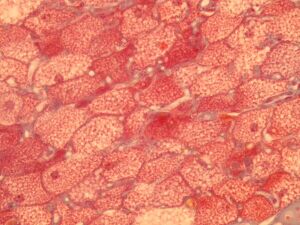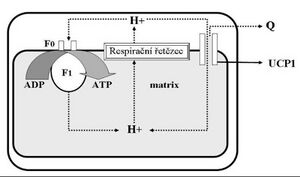Brown fat
Brown adipose tissue is essential for thermoregulation in newborns and persists in small amounts even in adults. It participates in energy metabolism. The mechanism of this process is well known. In brown fat, tissue-specific protein UCP1 (uncoupling protein 1) is expressed throughout an individual´s life.. In the mitochondrial membranes of brown adipocytes, it enables the uncoupling of the gradient of H+ ions, arising during respiration in the intermembrane space of the mitochondria, from the synthesis of ATP. The energy of the substrates is released in the form of heat[1].
UCP1 in the treatment of obesity[edit | edit source]
Already in the thirties of the 20th century, scientists tried to use this uninhibitating ability of brown fat mitochodnria to treat obesity.Unfortunately, it turned out that the artficial decoupling agent, which is 2,4-dinitrophenol (DNP), too often has significant side effects, starting with hyperthermia or tachykardií, and ending with death [2]. Today´s effort to treat obesity through increased thermogenesis focuses on the activation of the body´s naturally present uncouplers, UCP1 proteins [3].
Physiological role of UCP1[edit | edit source]
UCP1 is activated in the body in a number of common situations e.g. after eating (so-called diet-induced thermogenesis), by the intake of fatty acids in the diet ( direct participation of the negatively charged carboxyl group of free fatty acids in the transport of H+ions), by the action of cold ( the body´s natural need to warm up - the older name for UCP1 is thermogenin), by the action of thyroid hormones or by stimulation of β-adrenergic receptors through catecholamines.
Beige adipocytes[edit | edit source]
The representation of classic brown adipocytes tissue is very small in adults compared to newborns. Research into the localisation of the tissue and the measurement of its thermogenic activity runs into methodological difficulties.The technique used so far is demanding (it is [18F]FDG-PET/CT) and can capture the activity of human brown adipose tissue only partially[4]. Nevertheless, new insights are emerging. For example new types of fat cells have been discovered that, like brown fat cells, show thermogenic activity, but are scattered among white fat cells. These cells were called brite adipocytes (brown in white adipocytes) or beige adipocytes[5]. These cells increase the expression of UCP1 under the influence of cold, food or certain drugs from the the sympathetic activator series. In addition, it turns out that under suitable conditions, new beige adipocytes are formed in white fat from the precursors present here- we talk about the so-called browning of fat cells (browning of adipocytes). Today, characterized by any increasing number of obese people and diabetics it is not surprising that the list of substances and circumstances that have the ability to support the browning process of adipose tissue is expending every day. Of the natural influences of the environment, it is mainly cold. The latest studies point out that the increase in civilizational diseases such as obesity and diabetes can also be contributed to by an overly extended stay in a so-called thermoneutral environment, which does not require any thermal adaptation from the organism and therefore does not even activate UCP1 and potentiate the browning of adipocytes[4].
Current research focuses on the development of a non-invasive technique that would enable the study of biological processes regulating the differentiation and activity of brown and beige adipose tissue. It could help in the search for new treatments for obesity by increasing energy expenditure.
Links[edit | edit source]
Related articles[edit | edit source]
- non-shivering thermogenesis
- electron transport chain
- thermoregulation
- bioenergetics of the cell
- brown fat ( preparation)
- Adipose tissue
Source[edit | edit source]
- With the permission of the author according to Vejražková, D.: Brown adipose tissue in adults
References[edit | edit source]
- ↑ NICHOLLS, D G – BERNSON, V S – HEATON, G M. The identification of the component in the inner membrane of brown adipose tissue mitochondria responsible for regulating energy dissipation. Experientia Suppl [online]. 1978, vol. 32, p. 89-93, Available from <https://www.ncbi.nlm.nih.gov/pubmed/348493>. ISSN 0071-335X.
- ↑ GRUNDLINGH, Johann – DARGAN, Paul I – EL-ZANFALY, Marwa. 2,4-dinitrophenol (DNP): a weight loss agent with significant acute toxicity and risk of death. J Med Toxicol [online]. 2011, vol. 7, no. 3, p. 205-12, Available from <https://www.ncbi.nlm.nih.gov/pmc/articles/PMC3550200/?tool=pubmed>. ISSN 1556-9039 (print), 1937-6995.
- ↑ VOSSELMAN, Maarten J – VAN MARKEN LICHTENBELT, Wouter D – SCHRAUWEN, Patrick. Energy dissipation in brown adipose tissue: from mice to men. Mol Cell Endocrinol [online]. 2013, vol. 379, no. 1-2, p. 43-50, Available from <https://www.ncbi.nlm.nih.gov/pubmed/23632102>. ISSN 0303-7207 (print), 1872-8057.
- ↑ a b SCHRAUWEN, Patrick – VAN MARKEN LICHTENBELT, Wouter D – SPIEGELMAN, Bruce M. The future of brown adipose tissues in the treatment of type 2 diabetes. Diabetologia [online]. 2015, vol. 58, no. 8, p. 1704-7, Available from <https://www.ncbi.nlm.nih.gov/pubmed/25957230>. ISSN 0012-186X (print), 1432-0428.
- ↑ DEMPERSMIER, Jon – SUL, Hei Sook. Shades of brown: a model for thermogenic fat. Front Endocrinol Lausanne [online]. 2015, vol. 6, p. 71, Available from <https://www.ncbi.nlm.nih.gov/pmc/articles/PMC4424901/?tool=pubmed>. ISSN 1664-2392.


